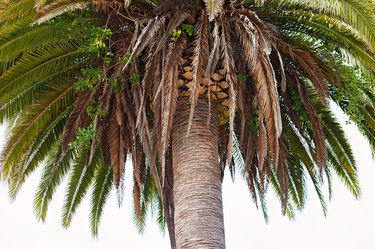
Native to Madagascar, the Majesty palm (Ravenea rivularis) appreciates lots of sunlight and moisture in a nutrient-rich soil. Not tolerant of subfreezing temperatures, Majesty palm is a perennial only in U.S. Department of Agriculture plant hardiness zones 10 and 11, but many Americans grow it as a container houseplant. Unfortunately, the low light and dry air extant in homes isn't ideal for the long-term health of this palm. Even if grown outdoors in tropical regions, leaf yellowing may still occur if there's a pest infestation or soil is too dry or devoid of nutrients.
Tip
A Majesty palm that's turning yellow may be plagued with a number of problems, including low light, nutritional deficiencies, insufficient water and insects feeding on the fronds.
Video of the Day
Improper Light Hinders Photosynthesis
A Majesty palm fares much better when basking in sunlight. If the light is too dim, plant growth slows and leaves begin to yellow and abort since not enough light sustains photosynthesis. Rather than stop producing new leaf spears, the plant devotes all its energy and resources to the newest, youngest fronds, letting the lower and oldest leaves yellow.
Video of the Day
When all palm leaves fail to produce enough carbohydrates from photosynthesis, the entire plant falters and yellows before dying. When grown indoors, a conservatory, solarium or atrium will work best as they will provide adequate light levels for long-term survival.
Nutrition Deficiencies Affect Palms
For healthiest growth, a Majesty palm needs fertile soil rich in organic matter, such as compost and replenished mulch dressings atop the soil. Soil fertility may be problematic in a confining small container in the house, or in soils that aren't acidic. The palm's roots continue to grow but encircle the pot's walls and bottom, and cannot come in contact with new sources of nutrients to sustain healthy green leaves.
Outdoors, sandy soils lack the ability to retain nutrients; rains and irrigation leach ions away from palm roots. When nitrogen, magnesium, manganese and iron do not exist in ample amounts in soil, the Majesty palm's fronds lose green chlorophyll and turn yellow. Specially formulated palm fertilizers contain these essential minerals for plant health.
Insufficient Moisture Causes Yellowing
Providing proper ambient and soil moisture for a Majesty palm is a delicate balance. In full sun exposures, the soil must remain evenly moist to keep leaves green. Low humidity and dry soil cause frond leaflets to brown on their edges, later followed by entire yellowing.
In the low light and dry air of a home or office, a Majesty palm is always at a disadvantage. Alternating between bone dry and wet soil from ill-timed waterings causes the palm to have yellow fronds and later die.
Pests Feed on Palm Fronds
Weakened or stressed Majesty palms become more susceptible to insect infestations. In particular, sap-sucking bugs drain the palm of moisture. This problem quickly manifests itself by yellowing leaflets on fronds.
Scale, mealybugs and spider mites occur frequently in indoor conditions. If not killed early on, these small pests proliferate and move all along frond parts into nooks and crannies. The piercing mouths of the insects drain the palm and accelerate yellowing, especially if the palm already is unhealthy from poor lighting, a nutrient deficiency or improper soil moisture. Use an insecticidal soap to control many insect pests, following all label directions, because some palms are sensitive to soaps and may be damaged by them.